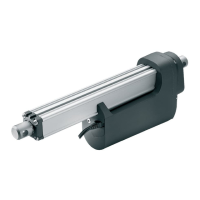Page 37 of 96
© 2020 LINAK A/S
Actuator with endstop signals and absolute positioning - PWM
I/O specifications:
Input/Output Specification Comments
Description The actuator can be equipped with
electronic circuit that gives an analogue
feedback signal when the actuator moves.
See connection diagram,
fig. 12, page 37
Brown 12, 24, 36 or 48 VDC (+/-)
12 V ± 20%
24 V ± 10%
36 V ± 10%
48 V ± 10%
Under normal conditions:
12 V, max. 26 A depending on load
24 V, max. 13 A depending on load
36 V, max. 10 A depending on load
48 V, max. 6.5 A depending on load
To extend actuator:
Connect Brown to positive
To retract actuator:
Connect Brown to negative
Blue To extend actuator:
Connect Blue to negative
To retract actuator:
Connect Blue to positive
Red Signal power supply (+)
12-24VDC
Current consumption:
Max. 60mA, also when the actuator is
not running
Black Signal power supply GND (-)
Green Endstop signal out Output voltage min. V
IN
- 2V
Source current max. 100mA
NOT potential free
Yellow Endstop signal in
Violet Digital output feedback (PNP)
10-90% (Option 5)
20-80% (Option 6)
Output voltage min. V
IN
- 2V Toler-
ances +/- 2%
Max. current output: 12mA
Frequency: 75Hz
It is recommendable to have the actua-
tor to activate its limit switches on a
regular basis, to ensure more precise
positioning
White Not to be connected
PWM
It is recommended that the actuator activates its limit switches on a regular basis, to ensure more precise
positioning. The actuator can also go into the position lost state. When the actuator goes in position lost state,
the feedback level will remain the highest level until the actuator is initiated. For instance, if feedback is 0-10 V,
the feedback level will remain 10V until the actuator is initialised. Both physical end stop switches need to be
activated for correct initialisation of the feedback. There is no rule as to which one needs to be activated first.

